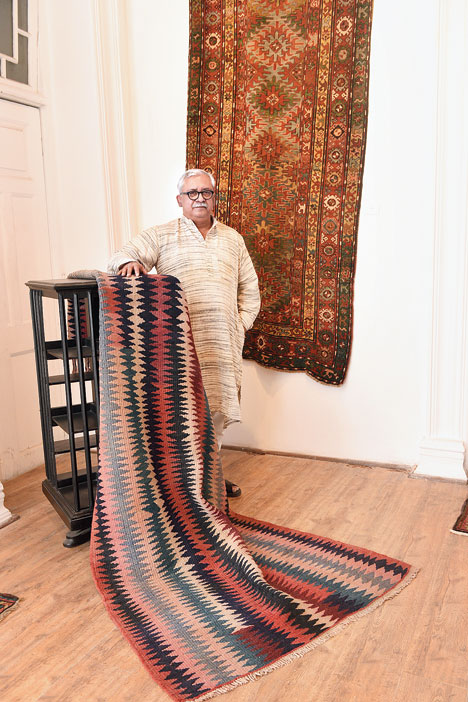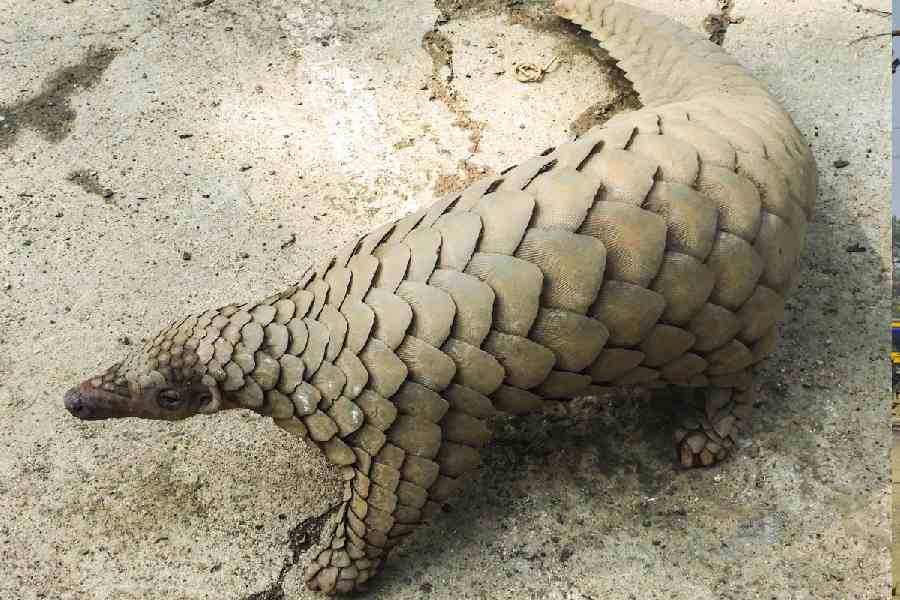
There are few things that get Bangalore-based Danny Mehra as fired up and happy as finding irregularities in the designs of what he calls “informal” carpets. For over two decades now, he has been collecting what nomadic womenfolk were painstakingly making in the late 19th century and the early 20th century in Central and West Asia.
He feels the quirks of design reflect the naivete of the women. For instance, in one of the carpets he owns, the design of the border was changed after it had been woven a foot or so and the weaver made no attempt to close off the carpet with the original design to maintain symmetry. And for these little whims of the women, every single piece in Mehra’s collection is unique.
“Each time you see one of these things you find something new. I look for things that bring out the soul of the weaver,” says Mehra, whose staggering collection of carpets comprises pieces from Anatolia (Turkey), the Caucasus (Armenia, Azerbaijan, Georgia and Dagestan), Central Asia (Uzbekistan, Turkmenistan and Kyrgyzstan), the Kurdish enclaves and Persia (Iran).
“These carpets came from the region covered by what’s known as the Silk Route. It began in Xian (China) and went all the way to the Roman Empire. There’s no one route; it kind of went zig-zag. The (carpetmaking) countries all lie on this. But none of my carpets are made of silk, all are made of wool,” he says.
To the womenfolk of the tribes in these places, carpet weaving was a technique that they also used to make saddle bags for their horses, prayer rugs, bags with narrow necks to carry their precious rock salt, pieces to use as curtains, bedspreads or blankets. And Mehra’s collection includes all of these.
In a way, says Mehra, he and other collectors of these carpets — he reckons there about 200-250 of them across the globe — might be saving a slice of history for posterity.

While the carpet-making tribes like the Qashqai, Luri, Bakhtiari, Khamseh, Afshar, Shahsavan, Turkic and Baluch still exist, their lifestyle has changed now. Over the last century or so, most of them have given up their nomadic lifestyle and, along with it, many of their traditions like making carpets by hand for personal use.
Tribal carpets in Mehra’s collection are of two broad types. There are the flat-weave kilims in which the patterns are woven with the tana-bana (warp and weft). Then there are pile carpets where a third dimension is added by woollen yarn that’s knotted onto the warp strings. Of course, there are further variations in the length of the pile, or like a piece in Mehra’s collection that’s a combination of weaves.
Mehra’s collection started with a couple of carpets he was given by his mother-in-law on his wedding. His own collecting began in 1992 with a $90 Iranian kilim that he picked up from a carpet shop in Manhattan and hung on his wall. But he doesn’t feel as proud of it any more. “It has hideous chrome dyes,” he says, and not the tonality of colours of his current collection. Later, on his visits to India, he would pick up carpets most of which “was really worthless stuff in that there were hundred others like them”.
Thus began the search for unique pieces. He has reservations about putting an exact figure on how many pieces he owns today, but he lets on that he can cover a football field with them and then some. In 10 years, by which time he would be 70, he expects to liquidate his entire collection.
Ulrich Schurmann of Germany, a passionate collector during his lifetime, is a hallowed name in the world of carpets. Pieces that were once in his collection are much sought after today as they have his stamp of approval. Mehra would be happy if something like that happened to him. It would be perfect for someone who is so passionate about imperfections.

MEHRA’S TIPS FOR BEGINNERS
How to start a collection
Follow your heart. That’s what I was doing. You will make mistakes. Don’t buy something just because someone tells you it’s an important carpet. Your heart will tell you what to buy. That’s the only rule. Don’t buy because you think it’s going to be an investment. In India there’s no regular source for buying these carpets. If you come across one or two you can start, but you will have to find them abroad.
How to avoid fakes
If one wants to make an imitation of a tribal carpet, it would probably cost more than it would to buy a genuine one that was made spontaneously by someone. It will take months to make a replica. Then there’s the quality of the wool and its silkiness that one comes to recognise. There are the colours as well — they mellow and become better with age. Usually, tribal carpets would have about 20 knots per square inch and going up to maybe 50 knots. These carpets are floppy. So you can fold them up like blankets.
How to determine when it was made
When a carpet is shown to experts, there could be different opinions. When these opinions start to converge, chances are they are right. But exactly when they were made isn’t as important as the fact that they are old enough to be interesting.
How to price a carpet
In the tribal carpets, knots per square inch is a completely useless indicator of value. For the carpets I am selling, it’s what I paid for them. I don’t do this to make a living and it’s art. So a small piece can be almost Rs 1 lakh. And there are others that are 10 times the size that are Rs 30,000 or Rs 40,000.
How to find the right pieces
In tribal carpets you cannot know what you are missing until you see it, unlike in a coin collection or a stamp collection where there is documentation and you can go looking for something specific. It’s when you see a piece that you say, “Aha, life doesn’t have any meaning without this.” Some collectors will go to almost any length to possess a piece they really like.











